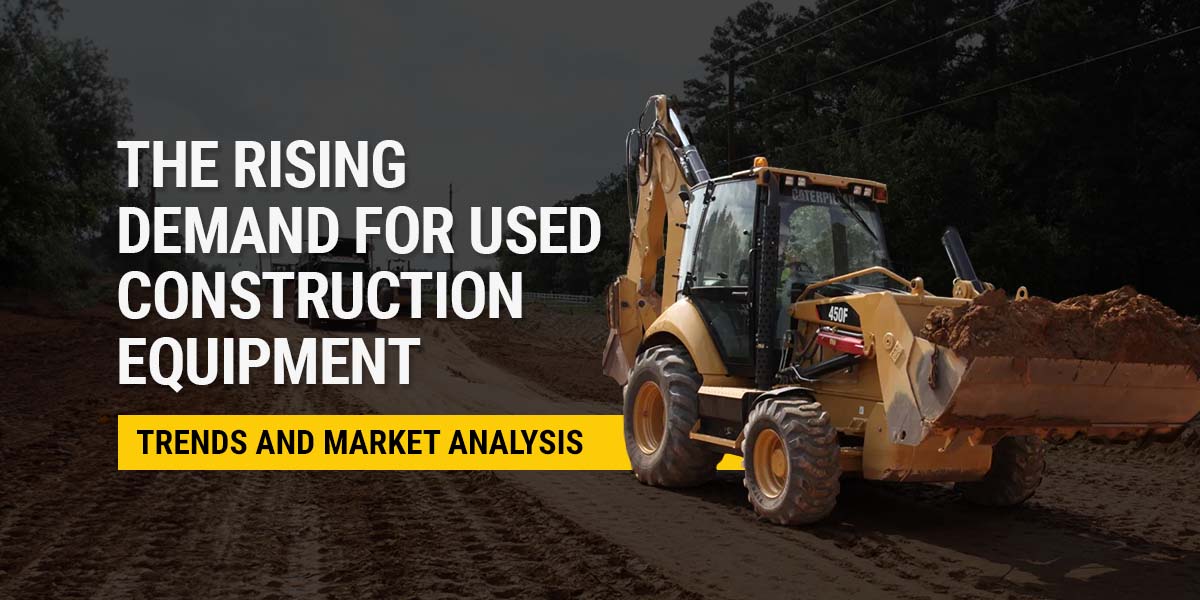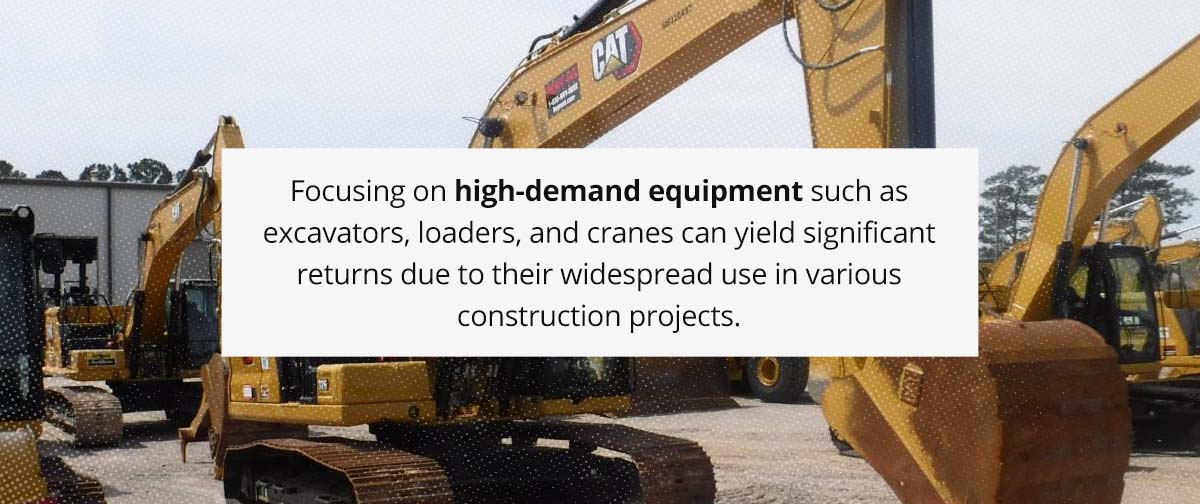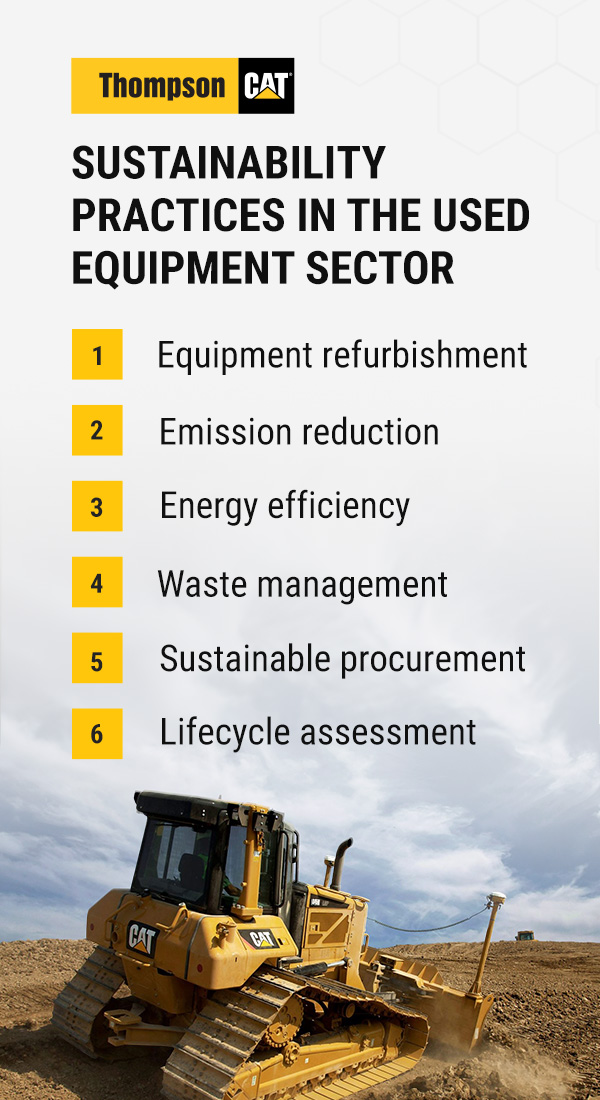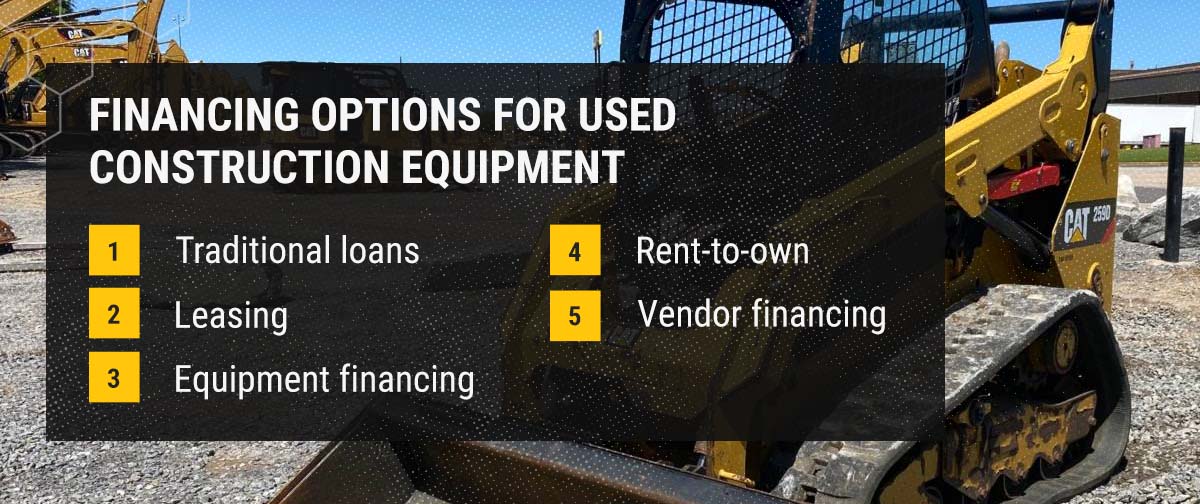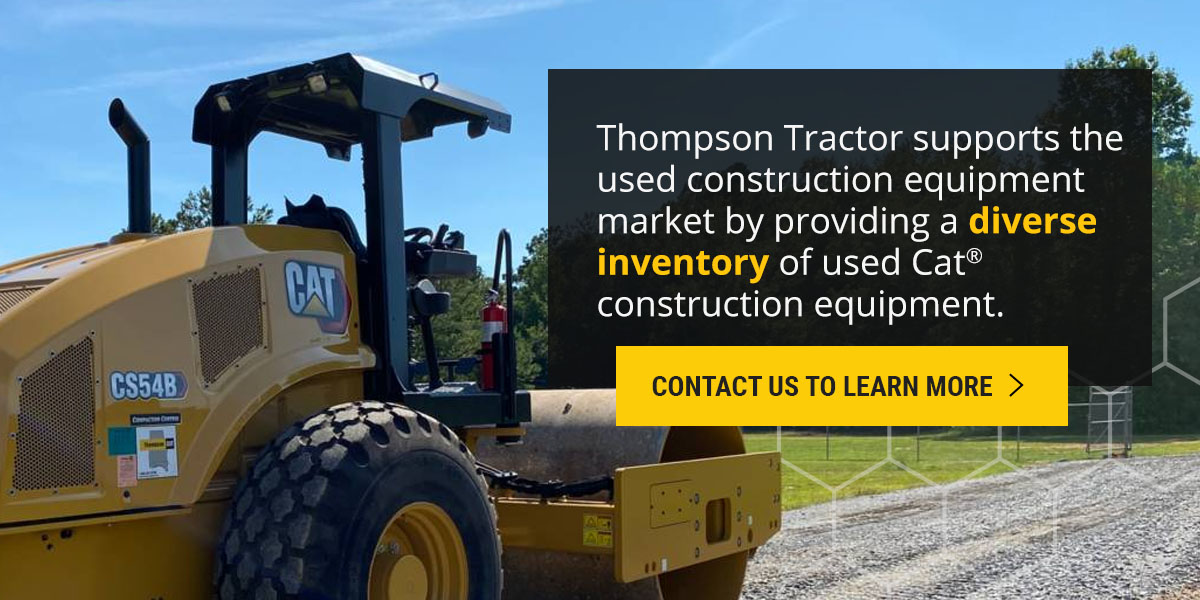Exploring the used construction equipment market involves evaluating the many factors that affect it. From demand trends and market dynamics to detailed investment analysis, several moving parts are at play. By understanding market dynamics and buyer preferences, stakeholders can make informed decisions to optimize returns in a dynamic sector.
How Big Is the Used Construction Equipment Market?
As of 2023, the market size for used construction equipment is $109 billion. Projections indicate that the market will be worth $152 billion in 2028.
The used construction equipment market is a significant segment within the broader construction industry. It’s driven by factors such as cost-effectiveness, availability, and technological advancements. With the construction industry being one of the largest industries globally, the demand for equipment remains robust. The market encompasses a wide range of machinery, from excavators to cranes and beyond.
Factors Influencing Market Growth
Factors influencing the growth of the used construction equipment market are multifaceted and can vary depending on the economic, technological, and regulatory landscapes.
- Economic conditions: Economic growth or recession directly impacts construction activity. This subsequently affects the demand for used equipment. Strong economic conditions often lead to increased construction projects, driving up demand for used equipment.
- Construction industry trends: Shifts in construction methods, such as modular construction or sustainable building practices, can influence the types and quantities of equipment needed, affecting the used equipment market.
- Infrastructure investment: Government spending on infrastructure projects affects the market. If government bodies invest in more roads, bridges, and utilities, demand for new and used construction equipment rises.
- Demographics: Population growth and urbanization drive the need for new infrastructure and real estate development. This spurs demand for construction equipment.
- Technological advancements: Innovation in construction equipment, like the integration of Internet of Things (IoT) devices, automation, and telematics, can impact the lifecycle of used equipment.
- Regulatory environment: Changes in environmental regulations and safety standards can affect the types of equipment in demand. These changes also influence pricing dynamics in the used market.
- Rental market dynamics: The availability and cost of renting construction equipment can impact the decision-making process for purchasing new or used equipment.
- Global trade dynamics: Tariffs, trade agreements, and currency fluctuations can influence the market by affecting the availability and cost of used equipment, especially for imported machinery.
- Availability of financing: Access to financing options and interest rates affect the affordability of purchasing new and used equipment, influencing market growth.
- Maintenance and repair costs: Maintaining and repairing used equipment can influence purchasing decisions, especially if newer models offer lower maintenance costs.
- Market saturation: Saturation in the new equipment market can increase demand for used equipment. Buyers may seek more cost-effective options, turning to used equipment alternatives.
- Industry consolidation: Consolidation among equipment manufacturers or rental companies can impact new and used equipment’s supply and pricing dynamics.
- Environmental awareness: Increasing awareness surrounding construction sustainability may influence preferences toward used equipment, which can be perceived as more environmentally friendly due to reduced manufacturing impact.
- Resale value: Resale value considerations, such as brand reputation, equipment condition, and market demand, influence the attractiveness of investing in used construction equipment.
- Market competition: The intensity of competition among sellers in the used equipment market can influence pricing and availability, affecting overall market growth.
- Market perception: Perception of used equipment quality, reliability, and performance relative to new equipment affects buyer preferences and demand in the market.
Investment Analysis in the Used Construction Equipment Sector
Investment analysis in the used construction market involves the evaluation of risks and opportunities. By conducting thorough investment analysis, stakeholders can make informed decisions to mitigate risks and capitalize on opportunities in the dynamic used construction equipment sector.
Identifying Profitable Investment Opportunities
Investing in the used construction equipment market presents several profitable opportunities for savvy investors. Firstly, focusing on high-demand equipment such as excavators, loaders, and cranes can yield significant returns due to their widespread use in various construction projects. These machines typically maintain their value and are in demand across different geographic regions.
Another lucrative investment avenue is specialized equipment catering to specialized industries, like tunneling equipment, forestry machinery, and paving machines. While these segments may have smaller market sizes, they often command higher prices due to their specialized nature and limited availability.
Targeting emerging markets or regions experiencing rapid infrastructure development can be highly profitable. These areas often have a growing demand for new and used construction equipment as they undergo urbanization and industrialization. Investing in refurbishing and resale operations is another avenue to explore. The right investment can generate substantial returns.
Technological advancements, such as telematics and IoT devices, can enhance the efficiency and productivity of used equipment and increase its value proposition. This makes it more attractive to potential buyers and drives profitability in the used construction equipment market.
Potential Investment Risks and How to Mitigate Them
There are several risks to be aware of when considering investing in the used construction equipment market. Economic fluctuations and market volatility can affect demand for construction equipment, leading to potential declines in resale value. Additionally, changes in government regulations and policies related to construction and environmental standards can impact the market dynamics and demand for certain types of equipment.
Another risk is the potential for unforeseen maintenance and repair costs. Used equipment may have hidden defects or wear and tear that could require significant rectification investment, cutting into potential profits. Moreover, market saturation and competition from other sellers can pose challenges. This is especially true in regions with a surplus of used equipment offerings.
To mitigate these risks, investors should conduct thorough research before making investment decisions. This includes assessing market conditions, demand trends, and regulatory environments. Performing comprehensive inspections and assessments of used equipment to identify any potential issues or maintenance needs can help minimize unexpected costs down the line.
Diversifying investments across different types of equipment and geographic regions can spread risk and reduce reliance on specific market segments. Developing strong relationships with reliable suppliers and establishing efficient refurbishment and resale processes can also enhance profitability and mitigate operational risks. Staying informed about industry developments and leveraging technological tools for equipment management and maintenance can improve decision-making and risk management strategies.
Making Informed Decisions
Making informed decisions in the used construction equipment market requires careful consideration of various factors. Conducting thorough research on market trends, equipment pricing, and demand dynamics is crucial. This involves analyzing historical sales data, monitoring market fluctuations, and staying informed about industry developments. Evaluating the equipment’s condition, age, and maintenance history is essential to assess its value and potential longevity.
Considering the specific needs of a project helps tailor equipment selection to optimize operational efficiency and productivity. By combining comprehensive research, extensive evaluation, and prudent decision-making, stakeholders can navigate the used construction equipment market effectively and maximize the return on investments.
Sustainability Practices in the Used Equipment Sector
Sustainable practices in the used construction equipment sector involve various strategies to reduce environmental impact, promote resource efficiency, and foster responsible business practices.
- Equipment refurbishment: Refurbishing used construction equipment extends its life span. It reduces the need to manufacture new machinery, minimizing waste generation. This practice also helps maintain equipment performance and reliability while reducing overall lifecycle costs.
- Emission reduction: Implementing emission control technologies and retrofitting older equipment with cleaner engines can help reduce air pollution and carbon emissions associated with construction activities. Upgrading equipment to meet current emissions standards contributes to sustainability.
- Energy efficiency: Promoting energy-efficient equipment and practices during equipment operation and maintenance can lower fuel consumption and minimize emissions. Employing technologies, like hybrid engines or electrification options, can further reduce energy efficiency.
- Waste management: Proper disposal and recycling of end-of-life equipment components and materials minimize landfill waste and promote resource recovery. Implementing effective waste management practices throughout the equipment lifecycle, including dismantling, recycling, and disposal, reduces environmental impact.
- Sustainable procurement: Encouraging certified or verified sustainable materials and components in refurbishment and maintenance promotes responsible sourcing practices. Partnering with suppliers committed to sustainability principles ensures the adoption of environmentally friendly solutions.
- Lifecycle assessment: Conducting comprehensive lifecycle assessments of used equipment helps identify opportunities for improvement and optimization across the entire equipment lifecycle, from manufacturing and operation to end-of-life disposal.
Cost-Saving Strategies for Acquiring Used Construction Equipment
Acquiring used construction equipment can offer significant cost savings compared to purchasing new machinery. Here are several strategies to optimize cost savings when acquiring used construction equipment:
- Auction purchases: Participating in equipment auctions is a great way to acquire machinery at competitive prices. Auctions provide opportunities to purchase used equipment from various sellers, including leasing companies, contractors, and equipment dealers.
- Direct purchases from sellers: Negotiating directly with individuals or companies can sometimes lead to favorable pricing, especially if the equipment has been on the market for an extended period. Building relationships with reliable sellers can also result in future cost-saving opportunities.
- Bulk purchases: Buying multiple pieces of equipment from the same seller or as part of a package deal can often result in discounts or reduced pricing per unit. This strategy particularly benefits contractors or rental companies looking to expand their fleets.
- Seasonal sales: Monitoring the market for seasonal fluctuations in equipment demand can present opportunities to purchase used machinery at lower prices during off-peak periods.
- Online marketplaces: Using online platforms and marketplaces dedicated to buying and selling used construction equipment can provide access to a wide range of inventory and competitive pricing. These platforms often allow buyers to compare prices and equipment specifications conveniently.
- Lease returns: Exploring lease return options can be another avenue for acquiring used construction equipment at reduced prices. Lease returns often involve well-maintained machinery that has been returned to the lessor after the lease period. This offers cost savings compared to purchasing new equipment.
Financing Options for Used Construction Equipment
Various financing options are available for used construction equipment.
- Traditional loans: This approach involves borrowing money from financial institutes or banks to purchase equipment outright. Repayment terms typically include fixed and variable interest rates and scheduled payments over a specified period.
- Leasing: In this option, you would enter into a lease agreement where you pay a monthly fee to use the equipment for a predetermined period. At the end of the lease, you may have the option to purchase the equipment at a preset price.
- Equipment financing: This is specialized financing tailored for purchasing equipment, often with flexible terms and repayment structures. This option allows businesses to conserve cash flow while acquiring essential machinery.
- Rent-to-own: This means renting equipment with the option to purchase it at the end of the rental period. A portion of the rental payments may be applied toward the purchase price, providing a gradual path to ownership.
- Vendor financing: This is financing offered by equipment dealers or manufacturers, typically with competitive rates and convenient payment terms. This option streamlines the purchasing process by integrating financing with equipment acquisition.
Navigating the Future of Used Construction Equipment
Over the next few years, used construction equipment market volume will see considerable growth, signifying the increasing demand for used machines across many sectors. A thorough analysis of the used construction equipment market is essential for maximizing investment returns and minimizing risks. By considering market trends, equipment conditions, and buyer conditions, stakeholders can navigate this sector effectively and capitalize on opportunities for growth and profitability.
The Role of Thompson Tractor in Supporting the Market
Thompson Tractor supports the used construction equipment market by providing a diverse inventory of used Cat® construction equipment. Our selection of used and rental equipment provides companies, contractors, and others with an array of machinery. Catering to a variety of project needs and budgets helps those in the market find what they need at affordable rates.
Providing quality assurance is another way we support the market. As a dependable Cat dealer, we ensure the quality of our new and used product selection. Our customers can trust that our Cat-certified used machines are in proper working order and will perform jobs as expected. Our available machinery matches the highest standards of the used construction equipment market.
The support services we offer take our offerings to the next level. From advice to maintenance, we offer a range of auxiliary services that go beyond our products. Thompson Tractor has been building relationships for over 60 years. We are reliable, trustworthy and experienced in the industry, so you know that everything we do is to support you and your project requirements.
If you’re located in Alabama or Northern Florida, we’re here to help. Contact us to find out more about the machinery we can provide you with and get advice on getting reliable Cat equipment for your construction needs.

